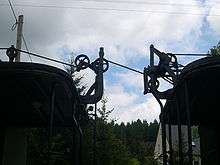Heberlein brake

Heberlein brake is a continuous railway brake used in Germany that is applied by means of a mechanical cable. Train braking is therefore initiated centrally from the locomotive using a winder. This causes the brake clips to be applied on individual wagons, assisted by a servo system which makes use of the rotation of the axle. The brakes operate automatically if the cable snaps. A typical feature of Heberlein brakes is the clearly visible cable run on top of the wagons, but cables can also be led underneath the wagons, as on the Spreewaldbahn railway line. Heberlein brakes were eventually largely replaced by compressed-air brakes or, sometimes, by vacuum brakes on narrow gauge railway vehicles.
Modern use
The Heberlein brake is still permitted as an operating brake on German railways due to it being both continuous and automatic, and at the low speeds on narrow gauge lines this means it is perfectly safe.
On several narrow gauge railways in Saxony, numerous vehicles with Heberlein systems can still be seen. These include the Lößnitzgrundbahn, Weißeritztalbahn and Rittersgrün narrow gauge museum railway. On the Preßnitztalbahn trains using Heberlein brakes run regularly, several times a year.
Operation
Because of the way they operate, there is a longer delay with Heberlein brakes before the brakes take effect when compared with compressed-air or vacuum brakes. As a result, locomotive and train crews have to be given appropriate training and experience when using this type of brake in practice.
Similar brakes
Germany
The Görlitz weight brake (Görlitzer Gewichtsbremse), a form of cable brake, operates in a similar way to the Heberlein brake, but differs markedly in its design details, as does the Schmid continuous spiral-toothed gear brake.
Great Britain
The chain brake, an early British railway brake, was similar to the Heberlein brake but used a chain, instead of a cable. An example was the Clark and Webb Chain Brake, used by the London and North Western Railway.[1] Early versions were non-automatic and would not stop the train if a coupling broke.